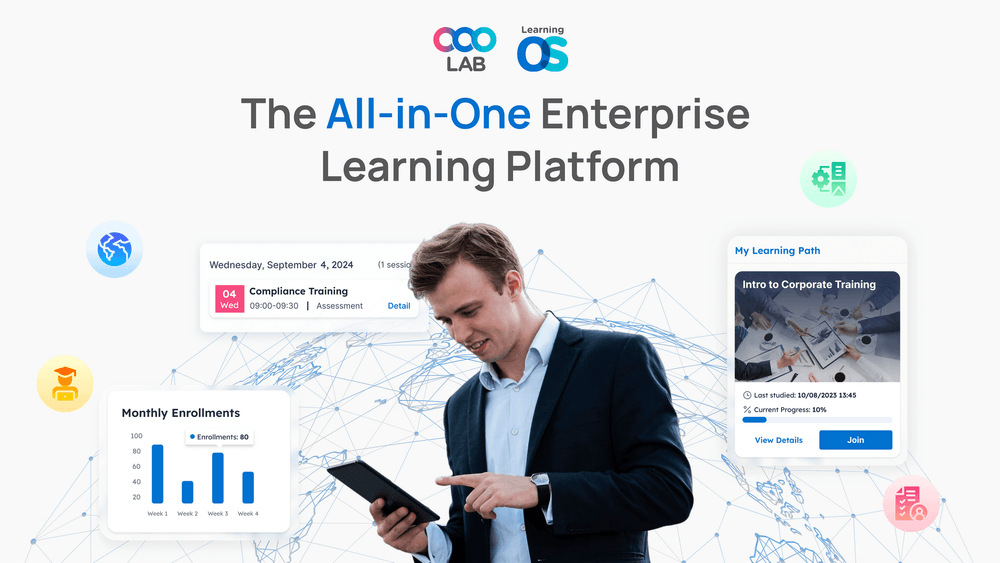

Choosing the right Enterprise LMS is a critical decision for businesses aiming to enhance workforce training and sales training programs. One of the key considerations is whether to invest in an open-source LMS or a proprietary LMS.
An open-source LMS is freely available for customization, allowing businesses to modify the software according to their needs. In contrast, a proprietary LMS is a commercial product offered by a vendor, typically with a licensing fee and dedicated support.
This blog explores the pros and cons of both LMS models, helping enterprises make informed decisions based on cost, flexibility, security, and long-term sustainability.

An open-source Enterprise LMS is developed and maintained by a global community, providing access to its source code. Organizations can modify and host the software on their own servers or use third-party hosting services.
Key Characteristics of an Open-Source LMS:
Free to use but requires hosting and maintenance
Highly customizable with access to the source code
Supported by a community rather than a dedicated vendor
Requires in-house IT expertise for setup and maintenance
A proprietary LMS is a commercial software solution provided by a vendor. It comes with built-in features, dedicated customer support, and security updates, but with licensing and subscription fees.
Key Characteristics of a Proprietary LMS:
Requires a paid license or subscription
Includes vendor support and maintenance
Limited customization compared to open-source options
Easier to implement with minimal IT expertise
>>> Read more: What is an Enterprise LMS
>>> Read more: Customization Options for Enterprise LMS
Cost Savings: Open-source Enterprise LMS platforms are free to use, reducing software costs. However, businesses must consider hosting, maintenance, and customization expenses.
Customization Flexibility: Organizations can modify features, integrate third-party tools, and develop unique functionalities to suit their specific training needs.
Community Support: A global community of developers and users contributes to updates, bug fixes, and troubleshooting.
No Vendor Lock-In: Businesses have full control over the platform and are not restricted by a vendor’s pricing structure or feature limitations.
According to eLearning Industry, 40% of enterprises opt for open-source LMS platforms due to their flexibility and cost-effectiveness.
Higher IT Requirements: Managing an open-source LMS requires technical expertise for installation, maintenance, and security.
Limited Support: Unlike proprietary solutions, open-source LMS platforms rely on community forums rather than dedicated vendor support.
Security Risks: Organizations must implement their own security measures, updates, and compliance frameworks.
>>> Read more: Common challenges when implementing an Enterprise LMS
>>> Read more: Steps to implement an Enterprise LMS
>>> Read more: Enterprise LMS - revolutionizing corporate training and development
User-Friendly Experience: Proprietary LMS platforms come with intuitive interfaces, reducing the learning curve for administrators and learners.
Dedicated Customer Support: Enterprises receive direct assistance from the vendor for troubleshooting, updates, and enhancements.
Security and Compliance: Proprietary LMS vendors provide security patches, data encryption, and compliance certifications to protect business data.
Seamless Integration: Many proprietary LMS solutions offer built-in integration with sales training software, HR systems, and CRM platforms.
A report by Gartner found that 55% of enterprises prefer proprietary LMS solutions due to their security and support features.
Higher Costs: Licensing and subscription fees can be expensive, particularly for large enterprises with thousands of users.
Limited Customization: Organization must work within the platform’s framework, limiting the ability to develop unique features.
Vendor Dependence: Businesses rely on the vendor for updates, pricing changes, and feature additions.
According to Mordor Intelligence, enterprises using proprietary LMS platforms spend 30-50% more on training technology compared to those using open-source alternatives.
Book Free Demo with us. Bring your Training and Learning to a new height with LearningOS.

Both open-source and proprietary LMS solutions have their advantages and drawbacks. The choice depends on an enterprise’s training needs, budget, IT resources, and scalability requirements.
For businesses that prioritize flexibility and cost savings, an open-source LMS offers unparalleled customization. However, for organizations seeking a hassle-free, secure, and vendor-supported solution, a proprietary LMS may be the better investment.
By evaluating long-term goals and workforce training demands, enterprises can make informed decisions that maximize the impact of their sales training and learning initiatives.
At OOOLAB (pronounced 'uːlæb'), our mission is to make complex learning operations simple. We aim to positively impact the lives of over 1,000,000 learners and educators by the end of 2026.
OOOLAB's LearningOS provides educational institutions and corporate enterprises with an all-in-one solution to create and deliver engaging learning experiences.
We meet organizations' needs or support your growth. We provide undivided attention. We provide:
1. Dedicated success manager: We offer direct communication with a real human who'll discuss your enterprises unique learning operations and goals.
2. Personalized setup: Our team will help you transition to LearningOS on your schedule, one step at a time.
3. Around the clock support: Get help from us any time, and in any time zone.
We have recently launched a new AI training tool, Skill Quotient OS, designed to elevate hybrid training to new heights. It offers role-play exercises with scenarios and assessments.This tool can apply in sales training, corporate development and customer support training in any industry.
Reach out to us at: LinkedIn, Facebook, Instagram, Tiktok, X
1. What are the main benefits of LearningOS
Our platform is easy to use and automates all aspects of your learning operations. It efficiently manages complex tasks, allowing you to concentrate on delivering exceptional learning experiences.
2. What main features does LearningOS offer?
Our all-in-one software solution combines a Content Management System, a Learning Management System, content authoring tools, and a mobile friendly Learner Portal.
3. Can your platform be used for corporate enterprises?
Absolutely! LearningOS is an Enterprise LMS is a great fit for corporate learning. In fact, we have clients with up to 700,000 employees using LearningOS! Upskill your workforce by creating and assigning interactive eLearning content while effortlessly tracking employee progress.
4. Who currently uses your platform?
Our platform is currently used by over 120,000+ learners, parents, and employees across 21 countries worldwide!
5. What types of content options are available on your platform?
We offer ready-to-go curriculums for various educational purposes or our expert design team can build a custom course for you. We can also upload your existing learning materials and enhance them digitally.
6. What is unique about LearningOS?
Our platform, designed by educators for educators, provides you with all the tools you need to scale. Build and promote your own hybrid and blended learning courses and save money on licensing fees by owning your own proprietary content.
7. How can I get started?
Schedule a meeting with our experts and we’ll talk about how our platform can address your unique challenges and help to grow your business.